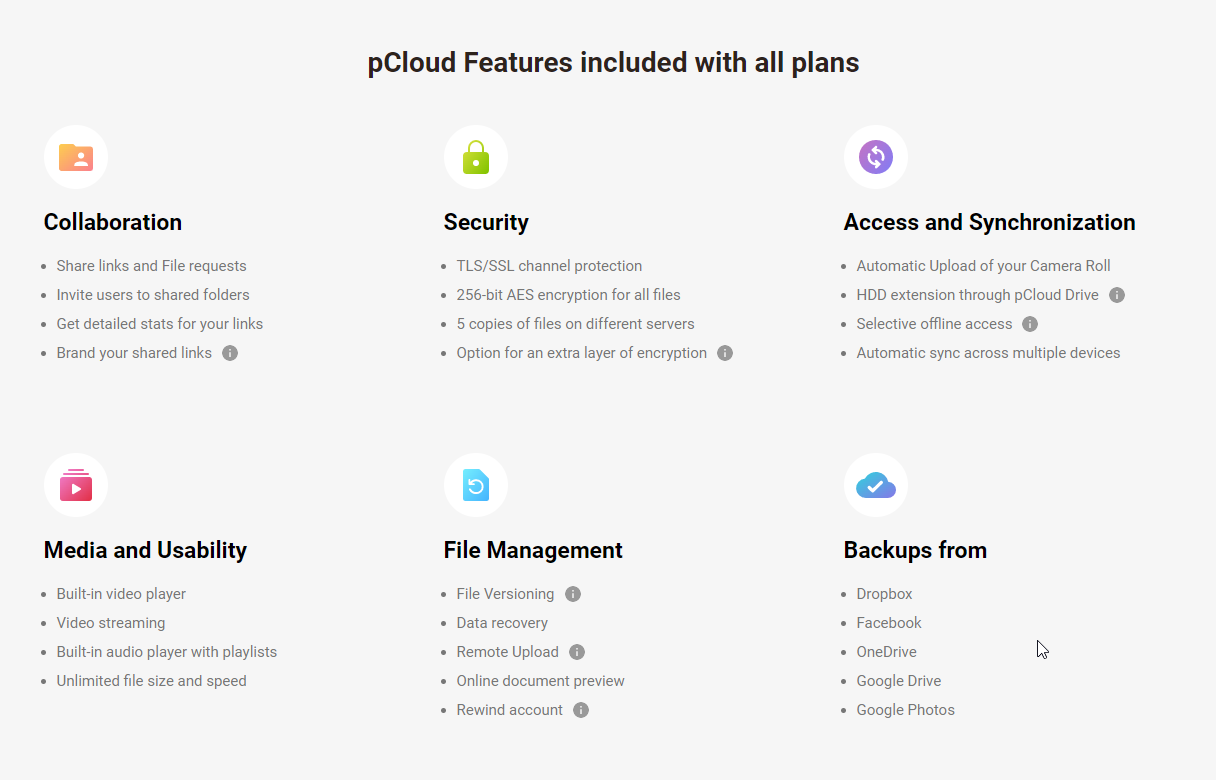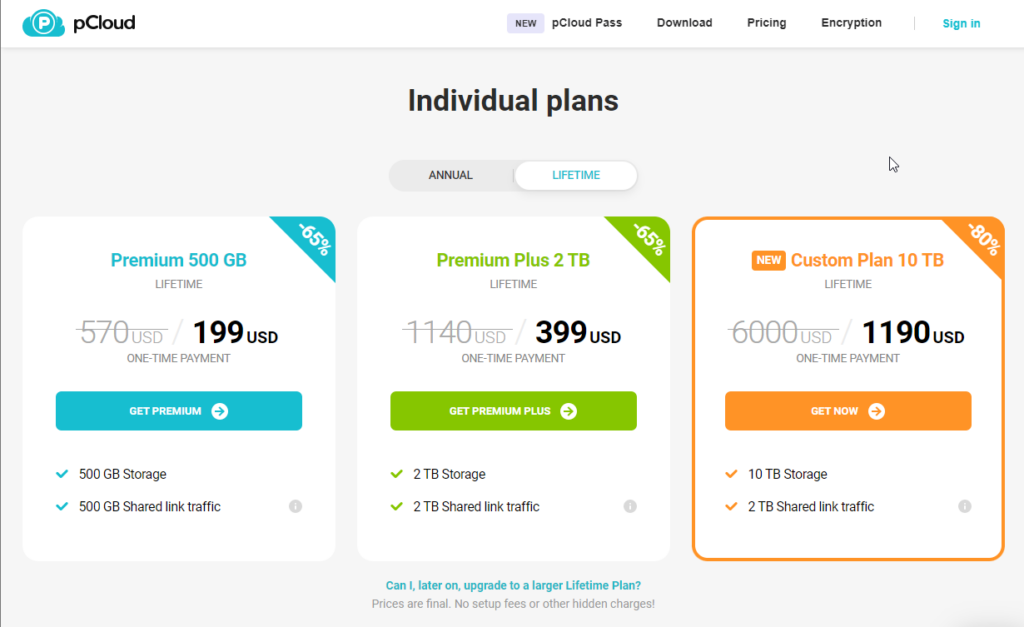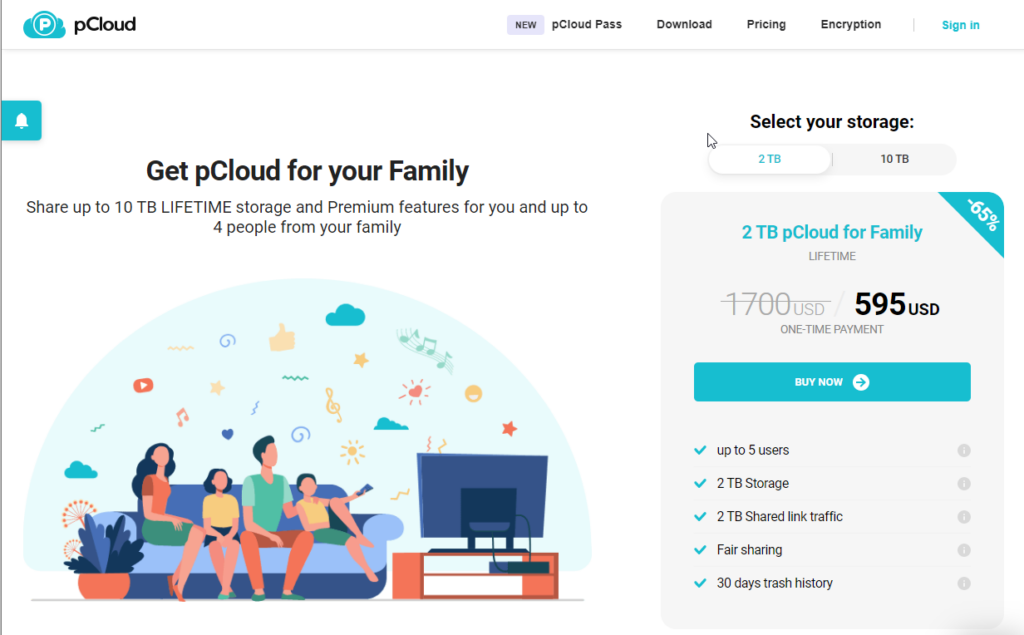Is pCloud's Lifetime Cloud Storage Deal Worth Getting?
Table of Contents
pCloud offers one-time payment plans they call “lifetime” deals. Important clarification: pCloud defines “lifetime” as “99 years or the lifetime of the account holder, whichever comes first” (source: pCloud Terms). This is more specific than most providers, which is a good sign.
Cautionary tale: Ganso and ThunderDrive both offered “lifetime” cloud storage, then shut down completely. Customers lost their files and money. This is the real risk with lifetime plans - you’re betting on company longevity.
pCloud has been around since 2013 (12+ years and counting), which is a solid track record compared to failed providers.
My commission from pCloud: I earn 35% commission on sales through my affiliate links. That’s a significant cut, and yes, it motivates me to recommend them. But I also use pCloud myself, which should tell you something.
My actual take: pCloud is legitimately good for what it does. I use it myself. The “lifetime” terminology is marketing language for “pay once, no recurring fees” - which is still a solid deal if the company stays in business (and they’ve been stable for over a decade).
⚡ 30-Second Verdict
TL;DR: pCloud’s “lifetime” plans are a solid deal. You’re prepaying ~4 years upfront, and given they’ve been stable since 2013, the odds of them lasting another decade are reasonable.
Quick facts:
| Plan | Storage | One-Time Price | Break-Even vs Annual |
|---|---|---|---|
| Premium 500 | 500 GB | $199 | ~4 years |
| Premium Plus | 2 TB | $399 | ~4 years |
| Ultra | 10 TB | $1,190 | ~4 years |
Use this if: You’re tired of subscription fatigue and want a one-time payment for long-term storage.
Skip this if: You need collaboration features (Google Workspace is better) or prefer the flexibility of annual payments.
What You Actually Get (The Good Stuff)

Apps That Don’t Suck
pCloud has apps for Windows, macOS, Linux, iOS, and Android. There’s also a web app if you’re into that.
The killer feature: pCloud Drive integrates directly into your file manager. It shows up as a virtual drive, so you don’t have to open some janky app every time you want to access your files. It’s like having an extra hard drive, except it’s in Switzerland and you’re paying for it.
Files you add to synced folders upload automatically. Edit a file on your laptop, it updates everywhere. It’s the basic cloud storage promise, and pCloud actually delivers on it without making you want to throw your computer out the window.
This is genuinely useful when you’re not at your desk and need that one file. No emailing yourself attachments like it’s 2005.
File Versioning (Actually Useful)
Every time you edit a file, pCloud keeps the old version for 30 days for paid/lifetime plans (15 days on free). This is called file versioning, and it’s saved my ass more times than I’d like to admit. You can extend history to 365 days with Extended File History (paid add-on).
Messed up a document and saved over it? You can revert. Deleted the wrong paragraph? It’s still there in yesterday’s version.
30-day retention is standard across the industry, but a lot of “free” providers don’t offer this at all (looking at you, Google Drive free tier). If you want extended version history, pCloud charges extra. Because of course they do.
No File Size Limit (Rare Win)
pCloud has no fixed file size limit for desktop uploads. You can upload very large files (e.g., 50GB videos). Many providers cap you at 2–10GB per file, which is impractical if you work with video, RAW photos, or large datasets. Note: web/app constraints can vary.
This alone makes pCloud worth considering if you’re a creative professional. Just don’t expect blazing upload speeds on a 50GB file - physics still applies.
Automatic Backup (Set It and Forget It)
Install the desktop app, select which folders to back up, and pCloud handles the rest. New files get uploaded automatically.
This is basic functionality, and pCloud executes it well, which is more than I can say for some providers.
File Sharing (Works, But Limited)
You can generate shareable links for files and folders. Add password protection if you want. Give edit access if you’re feeling trusting.
Here’s where pCloud falls short: No real-time collaboration. No simultaneous editing. No comments or version control for teams. If you need Google Docs-style collaboration, pCloud isn’t it.
It’s fine for “here’s the file, download it” sharing. It’s not a collaboration platform.
10 GB Free Tier (With Strings Attached)
pCloud offers 10 GB free if you jump through some hoops: verify your email, install their apps, upload a file, enable auto-upload on mobile. Complete the scavenger hunt, get your free storage.
Or you could just pay for it and skip the bullshit. Your time has value.
Want to test pCloud before committing to a “lifetime” plan? Use the free tier. Just know that some features (like the encryption add-on) aren’t available on free accounts.
The Pricing Reality (What You’re Actually Paying)
pCloud offers Individual Plans and Family Plans. Family plans let you split storage across 5 users, which sounds great until you realize you’re trusting your family members not to fill it with 4K vacation videos.
Individual Plans: The Math

Premium 500 (500 GB): $199 one-time
- Annual plan costs ~$50/year
- Break-even: 4 years
- Good for: Writers, developers, people who work with text files
- Not good for: Video editors, photographers, data hoarders
Premium Plus (2 TB): $399 one-time
- Annual plan costs ~$100/year
- Break-even: 4 years
- Good for: Graphic designers, moderate photo collections, small business backups
- Not good for: Anyone who shoots 4K video regularly
Ultra (10 TB): $1,190 one-time
- Annual plan costs ~$300/year
- Break-even: 4 years
- Good for: Video editors, large media libraries, professional photographers
- Not good for: Your wallet
The pattern: Every “lifetime” plan breaks even at 4 years. After that, you’re saving money compared to annual subscriptions. Given pCloud’s been around since 2013 and is based in Switzerland (stable jurisdiction, established company), they have a solid track record.
Why pCloud is safer than failed providers: Ganso and ThunderDrive shut down after offering lifetime plans. pCloud has 12+ years of operation, Swiss backing, and defines “lifetime” as 99 years - showing long-term commitment.
Family Plans: Sharing Is… Complicated

Family 2TB: $595 one-time (5 users) Family 10TB: $1,499 one-time (5 users)
Each family member gets their own account with their own private space. You can share files between accounts, but nobody can snoop on your stuff without permission.
The reality: This is great if your family actually needs shared cloud storage. It’s a waste if you’re just trying to split the cost with roommates who’ll bail in a year.
Also, good luck coordinating 5 people’s storage usage. Someone’s going to fill half the space with their iPhone photo library, and it’s going to cause arguments.
Better alternatives for comparison: Check out Icedrive’s lifetime plans (cheaper) or our full lifetime cloud storage comparison.
Pros and Cons
What pCloud Does Well
✓ Legitimate savings after 4 years - If you’re confident you’ll use cloud storage for 5+ years, the math works out
✓ No file size limits - Upload 50GB files without the service having a meltdown
✓ Virtual drive integration - Actually works like a local drive, not some clunky web interface
✓ File versioning - 30-day history saved my ass multiple times
✓ Swiss-based - Better privacy laws than US-based providers. pCloud isn’t zero-knowledge by default; full client-side encryption requires the Crypto add-on
✓ Apps don’t suck - Works on Windows, macOS, Linux, iOS, Android without major bugs
Where pCloud Falls Short
✗ “Lifetime” risk - It’s the company’s lifetime, not yours. If they go under, your money’s gone
✗ Encryption costs extra - pCloud Crypto (zero-knowledge encryption) is an additional $125 lifetime
✗ No real collaboration tools - If you need Google Docs-style features, look elsewhere
✗ Web app is basic - Can’t create/edit documents in-browser like Google Drive or Office 365
✗ Not the cheapest - Icedrive’s lifetime plans are cheaper for similar storage
✗ Upfront cost is steep - $199-$1,190 is a lot to drop at once, even if it saves money long-term
Bottom Line
Rating: 7/10 - Good product, solid track record
Use pCloud Lifetime If:
✓ You’re confident you’ll need cloud storage for 5+ years - The break-even is 4 years, so long-term usage makes sense
✓ You work with large files - No file size limits is a genuine advantage over competitors
✓ You want simple sync and backup - pCloud does this well without overcomplicating things
✓ You value one-time payments - pCloud’s been around since 2013 with a stable track record
Don’t Use pCloud Lifetime If:
✗ You need collaboration features - Google Workspace or Microsoft 365 are better for teams
✗ You want zero-knowledge encryption included - pCloud charges an extra $125 for pCloud Crypto
✗ You’re on a tight budget - $199-$1,190 upfront is steep. Icedrive’s cheaper if you’re price-sensitive
✗ You might change your storage needs - Annual plans give you flexibility. “Lifetime” locks you in
My Actual Recommendation
For individuals who need 500GB-2TB: pCloud’s lifetime plans are a solid deal IF you’re committed to using cloud storage long-term. The $199 or $399 one-time payment beats paying $50-100/year indefinitely.
For families: The family plans are overpriced. You’re better off getting individual accounts or using a service with better family sharing (like Google One).
For video editors/photographers: The 10TB plan at $1,190 is expensive but might be worth it if you’re currently paying $25-30/month for comparable storage elsewhere.
The honest truth: pCloud is good at what it does - simple, reliable cloud storage with decent security. “Lifetime” means one-time payment with no recurring fees, as long as the company operates. With 12+ years in business and Swiss backing, pCloud has demonstrated stability.
Alternatives to consider:
- Icedrive - Cheaper lifetime plans, similar features
- Best lifetime cloud storage comparison - See all your options
- Best free cloud storage - If you don’t need much space
